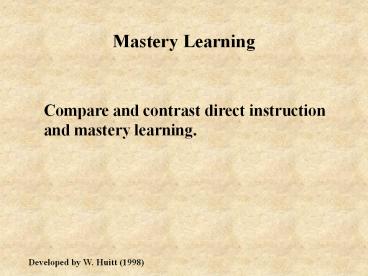Direct%20Instruction%20vs.%20Mastery%20Learning - PowerPoint PPT Presentation
Title:
Direct%20Instruction%20vs.%20Mastery%20Learning
Description:
Title: Direct Instruction vs. Mastery Learning Author: College of Education Last modified by: College of Education Created Date: 2/19/1999 4:33:28 PM – PowerPoint PPT presentation
Number of Views:89
Avg rating:3.0/5.0
Title: Direct%20Instruction%20vs.%20Mastery%20Learning
1
Mastery Learning
Compare and contrast direct instruction and
mastery learning.
Developed by W. Huitt (1998)
2
Direct Instruction
In general, all direct instruction models have
the following common principles
- More teacher-directed instruction (gt 50) and
less seatwork (lt 50)
- Active presentation of information (could be by
teacher, computer, another student)
- Clear organization of presentation
- Step-by-step progression from subtopic to
subtopic (based on task analysis)
3
Direct Instruction
In general, all direct instruction models have
the following common principles
- .Use many examples, visual prompts, and
demonstrations
- Constant assessment of student understanding
(before, during and after the lesson).
- Alter pace of instruction based on assessment of
student understanding
- Effective use of time and maintaining students'
attention
4
Direct Instruction
Direct instruction is more effective than other
models of instruction because it is more
efficient with the restricted amount of time
available for schooling.
Because it focuses on efficiency, there is also a
recognition that classroom management is
important.
5
Direct Instruction
However, there is generally no requirement of
direct instruction models to match instructional
objectives of the teacher to objectives that will
be tested outside the classroom.
6
Mastery Learning
Remember that Carroll proposed that school
learning is a function of time. To be more
specific, Carroll proposed that
School Learning
f
(Time Spent
/
Time Needed)
where
Time Spent
f
(Opportunity Perseverance)
and
Time Needed
f
(Aptitude, Prerequisite Knowledge, Quality of
Instruction)
7
Mastery Learning
Bloom reasoned that because student aptitude
varied, time needed to learn the required content
would vary.
If all students had the prerequisite skills and
received quality instruction, then all students
could learn required content if time was allowed
to vary.
8
Mastery Learning
In fact, Bloom states that 90 of students can
learn what is normally taught in schools at an A
level if they are given
- enough time and
- appropriate instruction.
9
Mastery Learning
Enough time means
- the Engaged Time required to demonstrate mastery
of objectives.
10
Mastery Learning
Appropriate instruction means
- course is compartmentalized into units of
instruction
- instructional objectives are developed for each
unit
- students are required to demonstrate mastery of
objectives for unit before moving on to other
units
11
Mastery Learning
In mastery learning, grades may be determined by
- Actual number of objectives mastered
- Number of units completed
- Proficiency level reached on each unit
- Any combination of above
Students can work at own pace if course is so
structured, but mastery learning can be
accomplished with group instruction.
12
Mastery Learning
The advantages of mastery learning include
- students have prerequisite skills to move to
next unit
- requires teachers to do task analysis, thereby
becoming better prepared to teach the unit
- requires teachers to state objectives before
designating activities
- can break cycle of failure (especially important
for minority and disadvantaged students)
13
Mastery Learning
The disadvantages of mastery learning include
- not all students will progress at same pace
- must have a variety of materials for reteaching
- must have several tests for each unit
- if only objective tests are used, can lead to
memorizing and learning specifics rather than
higher levels of learning
14
Mastery Learning
In summary, research suggests that when teachers
attempt to implement mastery learning in their
individual classrooms, the burden of producing
extra materials and the increase in time-off-task
leads to no superiority for this method.
15
Mastery Learning
However, when mastery learning is implemented on
a school-building level where extra time is
provided outside of the normal school day and
assistance is provided in developing additional
materials, mastery learning produces impressive
gains in student achievement.

